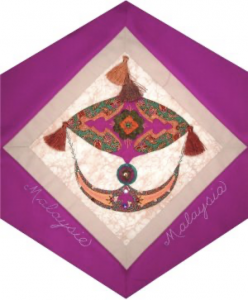Malaysia

The Block
Blockmaker Gillian Lee, has layered seven varieties of batiks––a traditional Malaysian fabric created from the ancient technique known as resist dyeing––to represent a wau, the uniquely designed kite for which the country is so well known. Silk-thread tassels, metallic thread embroidery and beadwork provide the finishing touches to the kite on the block. Kite-flying in Malaysia originated as a post-harvest activity, and while it continues as such today, wau festivals have become international events attracting participants from around the world. Waus are named after the shape of their wings as it is resembles an Arabic letter that is pronounced ‘wow’. The knowledge for making these kites is typically passed down from father to son and requires great skill and patience. During the process (which can take weeks to complete), bamboo is split to create a frame that is then covered with tinted, shiny, glazed paper. This bamboo frame causes the distinctive sound the kite makes when it is flown. Intricate floral cut-outs are pasted on, building up the design until the wau is ready for its final decoration – bright paper tassels. The block depicts a wau bulan, which was named for the resemblance of its tail to a crescent moon. The shape of this most popular style of kite was adopted as the logo for Malaysian Airlines. Wau bulans usually have a 2.5 metres wing span, measure up to 3.5 metres in height and can fly up to 500 metres high.
Cultural Profile
Malaysia, located in Southeast Asia, was formed in 1963 through a federation of the former British colonies of Malaya and Singapore (which seceded in 1965). It is comprised of 13 states: eleven in West or Peninsular Malaysia and two (Sabah and Sarawak) in East Malaysia, which occupies the northern section of Borneo Island. The country’s predominantly mountainous terrain includes two of Southeast Asia’s highest peaks: the Gunung Tahan (2,190 metres) and Gunung Kinabalu (4,100 metres). Malaysia is renowned for its insect population which includes many species of butterflies and moths. It has over 15,000 species of flowers and trees and 600 species of birds. Its capital city, Kuala Lumpur, is also the site of some of the world’s tallest buildings such as the Petronas Twin Towers. The country’s multicultural society includes Malays (the largest ethnic group), Chinese and Indians. The official language is Bahasa Malaysia (Malay), although English, Chinese dialects and Indian languages are widely spoken. Malaysians have a variety of lifestyles and many rural people still live in traditional kampungs, villages of homes built on stilts with wooden or bamboo walls and floors. Although the country is rapidly becoming an urbanized society, many city dwellers maintain strong ties to their kampungs. This can be seen especially during the festive seasons of Chinese New Year and Hari Raya Aidilfitri (the feast marking the end of Ramadan). Then Malaysians observing balik kampungs, meaning ‘return to the village’, flock to the ancient settlements in huge numbers, causing traffic jams. The culture is a mixture of Chinese, Indian, Middle Eastern and European influences and the people are known for a variety of artistic forms. Wayang Kulit involves the telling of epic Hindu tales through the use of shadow puppets and silat is a stylized martial art that has been practiced for hundreds of years. Music is based largely around the gendang (drum) but includes many other percussion instruments, such as the kertuk and pertuang. A strong tradition of dance includes the Joget, Mak Yong and Bangara. Among the best-known traditional crafts are Iban pua kumbu (intricately woven ceremonial hangings), silk weaving, and batik. Batik art usually displays hand painted motifs of butterflies, flowers and leaves with vibrant colours applied on silk or cotton. Silver filigree jewelry, woodcarvings, porcelain and beadwork are also notable crafts of the country. Malaysians have been immigrating to Canada since the late 1960s with nearly 7,000 arriving between 1973 and 1984. Some became involved in clerical, fabricating, and repair work, while others were involved in the fields of construction, sales, science, math, medicine and health. Since English is widely used in Malaysia, most immigrants settled in anglophone areas of Canada, including Ontario and British Columbia. As of 2011, there were over 14,000 people of Malaysian ancestry in Canada.
Sponsor: Picnic Grove Women’s Institute
